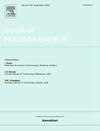Mechanistic CHF model development based on the liquid sublayer dryout model for flow boiling phenomena under IVR-ERVC conditions
IF 2.3
3区 工程技术
Q1 NUCLEAR SCIENCE & TECHNOLOGY
引用次数: 0
Abstract
In this work a mechanistic critical heat flux (CHF) model was developed based on the liquid sublayer dryout (LSD) model, designed to predict CHF in downward-facing flow boiling conditions, particularly the operational environment of In-Vessel Retention through External Reactor Vessel Cooling (IVR-ERVC). For accurate CHF prediction using the LSD model, several key parameters were properly defined: relative velocity between liquid and vapor, slug length, liquid velocity, and liquid sublayer thickness. In this study, these parameters were interpreted from the perspective of vapor slug dynamics, which have been well characterized through prior experimental observations. The developed CHF model was validated against previous well-established experimental results, including ULPU, FIRM, MIT, and KAIST experiments, with the CHF model demonstrating excellent predictability with a root mean square error of 14.53%.
基于液体亚层干化模型的IVR-ERVC条件下流动沸腾现象CHF机理模型的建立
本文在液体亚层干化(LSD)模型的基础上,建立了一个机制临界热流密度(CHF)模型,旨在预测下向流动沸腾条件下的临界热流密度,特别是通过外部反应堆容器冷却(IVR-ERVC)进行容器内保留的操作环境。为了使用LSD模型准确预测CHF,需要适当定义几个关键参数:液气相对速度、段塞长度、液体速度和液体亚层厚度。在本研究中,这些参数是从蒸汽段塞动力学的角度来解释的,这些参数已经通过先前的实验观察得到了很好的表征。开发的CHF模型与先前建立的实验结果进行了验证,包括ULPU, FIRM, MIT和KAIST的实验,CHF模型具有出色的可预测性,均方根误差为14.53%。
本文章由计算机程序翻译,如有差异,请以英文原文为准。
求助全文
约1分钟内获得全文
求助全文
来源期刊

Annals of Nuclear Energy
工程技术-核科学技术
CiteScore
4.30
自引率
21.10%
发文量
632
审稿时长
7.3 months
期刊介绍:
Annals of Nuclear Energy provides an international medium for the communication of original research, ideas and developments in all areas of the field of nuclear energy science and technology. Its scope embraces nuclear fuel reserves, fuel cycles and cost, materials, processing, system and component technology (fission only), design and optimization, direct conversion of nuclear energy sources, environmental control, reactor physics, heat transfer and fluid dynamics, structural analysis, fuel management, future developments, nuclear fuel and safety, nuclear aerosol, neutron physics, computer technology (both software and hardware), risk assessment, radioactive waste disposal and reactor thermal hydraulics. Papers submitted to Annals need to demonstrate a clear link to nuclear power generation/nuclear engineering. Papers which deal with pure nuclear physics, pure health physics, imaging, or attenuation and shielding properties of concretes and various geological materials are not within the scope of the journal. Also, papers that deal with policy or economics are not within the scope of the journal.
 求助内容:
求助内容: 应助结果提醒方式:
应助结果提醒方式:


